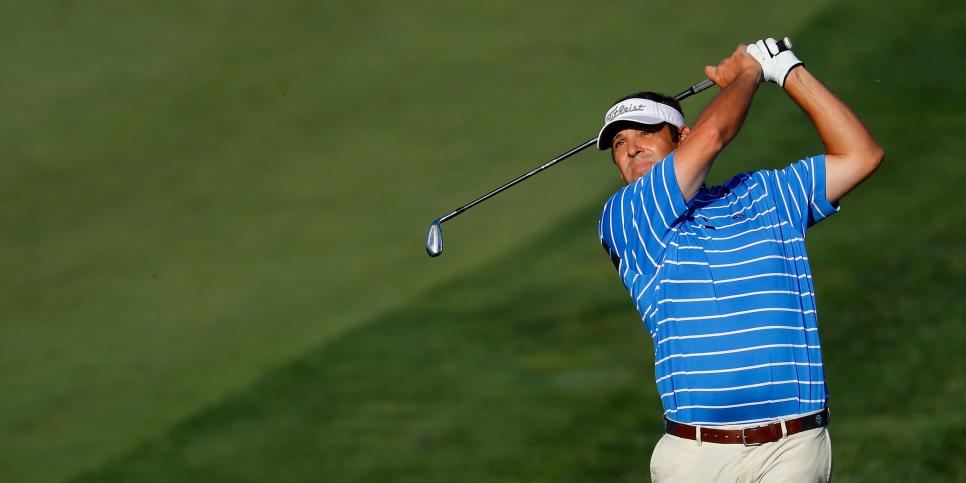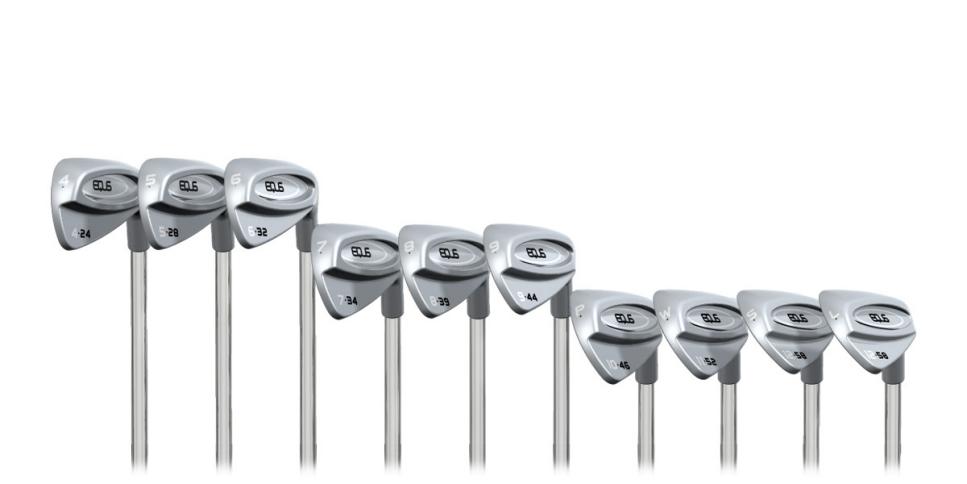News
Single-length irons: Can one size fit all?

David Edel, the golf inventor who developed the single-length irons that originally helped make Bryson DeChambeau famous, thinks the best way to understand the concept is to go back to the theories of a heretical Franciscan friar of the 14th century.
Really.
Crudely put, William of Ockham’s theory, now known as Ockham’s razor, goes like this: If there are multiple possible solutions or explanations to a particular problem, the simpler is usually the better.
“If golf didn’t exist and you were going to invent it and you had 14 different implements, no one would say, Hey, let’s make them all different lengths. No one would say that,” said Edel, who’s introducing his own set of single-length irons to compete in a market that now has at least 10 non-traditional-length iron sets, including two from Cobra (the company DeChambeau is now endorsing). “They would make them all one length and then they would say, ‘Well, we’re having distance problems so how do we offset that?’ They wouldn’t then immediately make them 14 different lengths. They’d say, ‘Let’s keep it pretty simple.’ ”
Of course, this simple concept isn’t exactly so simple. These days with more companies (mostly smaller) getting into the non-traditional shaft-length game and other larger manufacturers perhaps considering it, the idea facing golf consumers is whether this kind of simplicity is really the best solution.
•••
Before we go any further, let’s start here: According to industry research firm Golf Datatech, the two sets of single-length irons currently being sold at traditional golf retail—Cobra’s King F7 One and King Forged One, introduced last October—account for less than 2 percent of all irons sold. Impressive, perhaps, but not quite a revolution.
Still, Cobra’s team is encouraged.
“Most people struggle with golf, and if you give them some simplicity, and then they see some benefit, there’s a good reason to think it will be successful,” said Tom Olsavsky, Cobra’s head of research and development. “It’s appealing to that idea of I want to hit it more consistently. To say that consistency gives you more distance can be a hard argument to make. But if people do try it and they find it to be easier, they’re going to find that at the end of the day it does go farther. We kind of have to swim upstream a little bit on that.”

Justin Kosman
But others in the non-traditional camp are even more bullish, led by early advocates like Jaacob Bowden, who worked with veteran club wizard Tom Wishon on the Sterling iron set that’s become the component club industry’s cult favorite over the last 18 months. Bowden, a one-time 14-handicap who took his game to the professional level by playing single-length irons, believes the logic is irrefutable and feels the obstacles are largely the result of “we’ve always done it this way” thinking.
“Larger companies weren’t doing this as a result of misguided manufacturing decisions made earlier in the 20th century,” Bowden says on his website, Swingman.com. “Now that thousands and thousands of iron sets have been made this way, consequently I think the modern golf psyche is now so deeply entrenched in the idea that irons have to all be different lengths, that no major manufacturer is willing to take the risk at trying to change the design perception of the entire golf industry. Even though the science supports same length clubs, we’re still stuck where we are because of a mix of stubborn tradition and a business risk that few will take on.”
Mind you, the risk is an easier, though not less complicated, one for smaller companies such as Edel. But the man who’s worked with the most successful single-length player in the history of the game said DeChambeau’s play is having an effect on the tour player’s mindset.
“I’ve heard from a multiple major-championship winner that in five to eight years you’ll see a quarter of the players on tour playing single length,” Edel said.
Already, Matt Dobyns, a two-time winner of the PGA Professional National Championship, has played custom-built single-length irons, and the club pro made three cuts last fall on the PGA Tour. Wes Skaggs, another club professional who has played in the PNC, has been a recent convert, even though he had no interest in switching. Skaggs was providing some ball-flight data for Edel earlier this year when the numbers with the shorter-length 4-iron shocked him.
“I was hitting this 4-iron 10 to 15 yards farther, and I just didn’t want to believe it,” Skaggs said. “I’d been playing variable length shafts for 30 years at a high level. I’m a traditionalist. I had zero intention of switching, I’d already ruled it out, and 30 minutes later I’m telling him to build me a set.
“Honestly, it spooks you a little bit, but once you understand that this is going to perform better, it’s going to go just as far, it’s going to be more accurate and it’s going to be more consistent, then bam, you’re off and running. It’s a total game-changer once you finally commit.”
•••
Of course, the success of a better player is always more the golfer than the equipment. The real test, and quite frankly the real benefit, of the concept lies in what it does for regular golfers.
When Golf Digest put Cobra’s King F7 One through its evaluations at the annual Hot List Summit last fall, Cobra’s King F7 traditional-length irons were preferred over its single-length fraternal twin, but only slightly. Nine of the 16 players rated the F7 better, while four favored the single-length option and three judged them to be about the same.

Stacy Revere
While DeChambeau spoke of his win at last fall’s DAP Championship in the Web.com Tour Final Series as “the day the game changed,” the benefits of the single-length concept still seem no less dramatic than its challenges.
The benefits are at once obvious and complex. The same shaft length for every iron in the set means the posture, the ball position and the swing itself are exactly the same for your 4-iron as they are for your wedge. That sounds like it should be easy, but how do you compensate for the lost speed or excessive flight at either end of the iron set so that your single-length set produces the distance gaps crucial to accurate iron play?
Cobra is the first major manufacturer to explore this idea in decades, offering two sets as alternatives in its current line. Cobra’s Olsavsky believes the distance benefit is hidden but real in single-length irons. So much so, that he said single-length is “not just a one and done” for Cobra. “There are a number of things that we want to look into longer term. You’ll hear more about how we’re going to continue to execute this concept.”
Also, hidden and potentially even more beneficial is what longer wedge shafts might do for mediocre players, he said.
“The biggest benefit that we have not sold a lot of is how much better the short game is for people whose short games’ suck,” Olsavsky said. “This is something we will see more over time as we get more and more of these sets out there. Teachers have told us repeatedly, ‘I can get some players to be a lot better in their short game just because of the one setup.’ With the number of shots around the green average golfers hit right now, we think this is a big recipe for improvement.”
Skaggs, who believes single-length won’t take over the game quickly and immediately but will be more like the gradual but definitive movement away from persimmon woods to metal drivers, sees single-length from the perspective of a teacher, too. He thinks single-length makes the game easier and less time consuming to both teach and practice.
“You know that if your swing is on with your 7-iron it’s going to be on with every other club, and you also know that if there’s a swing flaw with your 4-iron, you can fix that and you’ve fixed it for your whole bag.”
“It isn’t just great for elite-level golfers, but junior golfers, middle-handicap golfers and even beginners,” he said, noting that the shorter long-iron shaft will lead to more players learning the correct downward angle of attack into the ball on their mid- and long irons rather than the sweeping motion that leads to mishits. “It would be great for beginners because they’ll only have to work on one swing, they’ll never have to try to learn to hit a 3-iron. They don’t have to learn the fine-tuning, the little adjustments of ball position and stance or swing path or plane for each different club.
“You know that if your swing is on with your 7-iron it’s going to be on with every other club, and you also know that if there’s a swing flaw with your 4-iron, you can fix that and you’ve fixed it for your whole bag.”
But there’s far from universal acceptance in that thinking. Those manufacturers who’ve taken a pass for the moment on single-length irons harp on distance problems with the set.
Said Cleveland/Srixon’s Brian Schielke, senior product manager for golf clubs, “The single lengths we’ve found hit super high wedges and super low long irons, which makes both distance gapping and control difficult.
“People struggle hitting their long irons too low as it is. This just accentuates that even more.”

Kevin C. Cox
•••
Regarding distance, our own testing of single-length irons at Golf Digest’s Hot List Summit last fall found, whether it was faster swingers or slower swingers, the lower-lofted irons on the single-length sets carried shorter distances, but the higher-lofted irons tended to fly a little farther. The total range of distance between 4-iron and 9-iron was shorter with the single-length set than with the traditional length, a verdict that independent golf research Dave Tutelman found to be similar throughout single-length designs. But Tutelman believes there is a way around the distance gapping issue, specifically with the higher-COR iron designs in the lower lofts we’re seeing from some companies like Edel and Cobra and something we’re not always seeing: higher loft spacing through the set like we see to a certain extent with the Bowden-Wishon Sterling irons, which are now being marketed by U.K. component brand Diamond International.
“It is especially important for single-length sets, because you don’t get any extra clubhead speed from club length,” he writes in an extensive essay on his website, tutelman.com. “One thing that does not work is more of what the major companies have been doing: making stronger middle irons resulting in small loft spacing on the less-lofted irons.”
The larger problem Cleveland/Srixon’s Schielke said is that proper distance gapping comes not because loft is more important than speed (the single-length idea) but because loft has to work with speed (more easily produced by graduated shaft lengths) to achieve distance.
“If you think about why amateurs have moved to hybrids or combo iron sets, it’s because they can’t keep their long irons in the air long enough,” he said. “Creating shorter long irons exacerbates this problem for them.”
“People struggle hitting their long irons too low as it is. This just accentuates that even more.”
There is the question of whether a 7-iron shaft length throughout the set is the ideal length for all players. The Sterling set of single-length irons start with an 8-iron shaft length but can be built to half-inch and full-inch longer lengths. Edel believes fitting may play an even more crucial role in getting players in the right length than it is in traditional graduated length sets. Edel’s SLS-01 set uses a fitting matrix that involves seven different weight screws that can change head weight by two to 14 grams, three uniquely designed graphite shaft profiles from Paderson Kinetixx, three different shaft weights, four different shaft flexes and two lengths.
Fundamentally optimizing each individual shaft profile can make lower lofts produce more distance and height, as does making faces thinner on low-lofted irons, things both Edel, Wishon and Cobra are attempting to varying degrees.
•••
As the idea of changing the thinking behind the makeup of your typical iron set gains momentum, there is a third idea starting to circulate. The Equs A-1 irons offer three groups of irons within the set with three different shaft lengths: 4-iron, 7-iron and pitching wedge.
Developed by long-time physician Mike Lytle and veteran club designer Jeff Sheets, the theory again emphasizes simplicity, and it’s somewhat similar to the first set of irons Bobby Jones designed for Spalding in the 1930s, which featured matched lengths in pairs through the set.

“If they hit their 4-iron, their 7-iron and their pitching wedge,” Lytle said. “Then they can hit every club in the set. By decreasing the whole set down to just three swings you’re improving your consistency and how you play just because you have less swings to learn. That would apply to any group of players.”
Of course, such a set presents the same kind of challenge as single-length does: Getting players to switch isn’t about really a fitting, it’s about a longer trial period where a player can actually see whether his scores are changing. That is a hard ask in an environment where golfers are increasingly expecting a launch monitor to spit out a number instantaneously that says a new club is better than an old club.
“Golf is very slow evolving,” Sheets said. “The attitude is so ingrained in the equipment industry and is so hard to overcome sometimes that even when you design a better mousetrap, it’s not going to make it to market because there’s so much resistance to it. When you choose to go off the beaten path the customer tends to resist.”
Still, Olsavsky concedes, “We know they don’t work for everybody. That’s why we make a bunch of other kinds of clubs.”
But what is that single-length or non-traditional-length demographic breakdown? Is the current 2 percent Golf Datatech has recorded a fad or the early moments of a tipping point? Olsavsky believes “somewhere between 30 and 50 percent are going to be accepting of the setup, the conditions, the distances and the ball flight.” That of course is merely hopeful speculation. What may be more telling is this: Several major manufacturers who do not make single-length irons were contacted for this story. Aside from one, all declined to offer comment. Are they trying to kill the momentum or simply hedging their bets in case the opportunity to pursue single-length becomes too obvious to ignore?
Maybe for a real solution, we should return to Ockham’s Razor and the idea of simplicity as the best way to approach a problem. Ockham, you’ll recall, was charged with heresy in the 1300s for his radical ideas, arrested, never returned to his academic career and never reconciled with the Catholic Church.
But about 650 years later, Ockham and his razor appeared in Stephen Hawking’s groundbreaking work A Brief History of Time. Paraphrasing only a little, Hawking attributes the discovery of quantum mechanics, perhaps the most important scientific theory of modern times, to Ockham’s razor.
Vindication of a sort, albeit belated. We might not have to wait that long for a consensus on single-length irons.